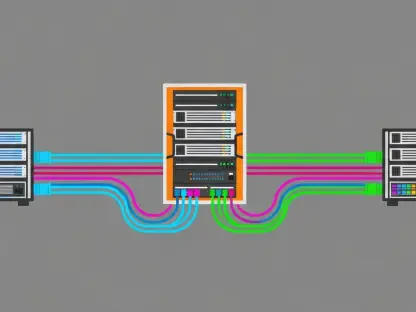The debate between on-premises IT and cloud computing has been ongoing for years, with cloud computing seeing considerable growth and adoption due to its promise of scalability, flexibility, and cost management. Emerging trends and considerations, however, suggest that on-premises IT might see a resurgence by 2025, driven by factors that challenge the assumed dominance of cloud solutions. This article delves into these factors, highlights the advantages of on-premises IT, and evaluates the ongoing balance between cloud and on-premises approaches in the rapidly evolving IT landscape.
The Evolution of Cloud Computing
Cloud computing has significantly transformed the IT landscape, offering tremendous scalability, unparalleled flexibility, and an array of services to businesses across various industries. When it first gained traction in the early 2000s, the cloud was hailed as the future of IT, promising immense cost savings and simplified management. Public cloud providers, such as Amazon Web Services (AWS), Microsoft Azure, and Google Cloud Platform, quickly became dominant players by promoting their platforms as comprehensive solutions for nearly all IT needs.
However, the initial excitement surrounding cloud computing has since been tempered by a more nuanced understanding that recognizes its limitations. The concept of “cloud is for everyone, but not necessarily everything” has gained prominence, emphasizing that while cloud solutions offer numerous advantages, they may not always be the optimal choice for every scenario. This realization has driven a reevaluation of on-premises IT, especially for specific applications and data requirements where cloud solutions may fall short.
On-Premises Advantages: Cost, Security, and Performance
Cost is one of the primary drivers behind the potential resurgence of on-premises IT. Larry O’Connor, founder and CEO of Other World Computing (OWC), highlights the substantial expenses now associated with cloud services, which have prompted many businesses to reconsider their reliance on the cloud. While cloud storage was initially attractive due to its low costs, prices have increased significantly over the years, making on-premises solutions more appealing for certain use cases. The ability to manage and cap expenses more effectively is a crucial factor forcing this reconsideration.
Additionally, security remains a critical factor influencing the shift back toward on-premises IT. On-premises infrastructure can offer enhanced security measures for sensitive data, thereby reducing the risk of large-scale breaches that can occur with cloud storage. Smaller businesses, in particular, may find local data storage to be a less attractive target for cyber-attacks compared to cloud storage, which pools vast amounts of data from various sources, potentially attracting cybercriminals.
Performance is another significant consideration that makes a compelling case for on-premises IT solutions. On-premises infrastructure can provide faster data access and processing speeds, which is crucial for applications requiring high bandwidth. Localized environments excel in data analytics, storage, and core compute functions where performance and speed are essential. In contrast, cloud-based solutions may face latency issues, constrained bandwidth, and additional costs for premium performance.
AI and On-Premises IT
The integration of artificial intelligence (AI) capabilities on-premises is emerging as another strong argument for the resurgence of on-premises IT. According to O’Connor, on-premises AI enables organizations to harness powerful data processing and analysis tools without the exorbitant costs typically associated with cloud-based AI solutions. Running AI locally ensures that proprietary data and algorithms remain secure within the company’s controlled environment, mitigating the risk of data exposure to third-party entities.
This approach also helps prevent “data bleed,” where proprietary information could inadvertently enhance third-party models or be accessed by external entities. By democratizing AI capabilities, on-premises solutions empower smaller businesses with advanced analytics tools, allowing them to leverage AI for strategic insights while safeguarding their sensitive data. This capability is particularly valuable in a competitive landscape where data security and proprietary knowledge are paramount.
Cost-Effectiveness and Resilience
When it comes to backup strategies, O’Connor emphasizes that cloud solutions should ideally serve as a tertiary option, supplementing a robust local backup strategy. Local backups tend to be more cost-effective and readily accessible, providing faster and more efficient recovery options in scenarios requiring immediate data retrieval. In contrast, recovering data from the cloud can be time-consuming and costly, especially in emergency situations.
At scale, owning and maintaining AI equipment on-premises can promise significant long-term benefits in terms of security and resilience. The same open-source tools utilized in cloud environments can be securely executed on-premises. Although cloud options are excellent for small-scale experimentation due to their flexibility, significant data sets for AI learning or training are ideally processed on-premises to mitigate ongoing expenditure and ensure full control over the data lifecycle.
Balancing On-Premises and Cloud Solutions
Despite the advantages of on-premises IT, public cloud providers offer considerable benefits, including vast scale, lightning-fast speed, and an extensive array of services that attract many organizations. These attributes are particularly enticing for companies looking to innovate rapidly and scale their operations effortlessly. However, for tasks that require extremely high interface speeds, such as 7000MB/s, on-premises solutions significantly outperform typical cloud speeds of around 100MB/s.
O’Connor believes that on-premises solutions can be highly beneficial for many small to medium-sized organizations by allowing them to cost-effectively and resiliently deploy AI applications. The hybrid approach, which balances both on-premises and cloud solutions, appears to be the most prudent strategy for many organizations. This approach enables businesses to leverage the cloud for its scalability and flexibility, while still retaining the security, cost management, and performance advantages of on-premises solutions.
Industry Perspective
Beyond OWC’s perspective, Vadim Tkachenko, technology fellow and co-founder at Percona, adds an industry-wide viewpoint on the evolving landscape. He acknowledges the challenges in predicting a massive wave of data repatriation by 2025 but suggests that an inflection point is approaching. As organizations strive to control costs, enhance usability, simplify deployment, and automate processes, they might consider bringing their data back in-house through on-premises or private cloud environments.
Tkachenko observes that businesses, particularly in the tech sector, are reacting to economic pressures by tightening their budgets and seeking more efficient solutions. As the deployment and management of databases become easier, more organizations might regain the confidence to reclaim their data from public cloud providers, reducing expenditures and increasing control over their IT infrastructure. This trend, driven by financial prudence and the desire for greater autonomy, further supports the case for a resurgence of on-premises IT.
The Future of IT: A Hybrid Approach
The debate between on-premises IT and cloud computing has been ongoing for years, with cloud computing witnessing significant growth due to its promise of scalability, flexibility, and better cost management. However, recent trends suggest that on-premises IT might experience a resurgence by 2025, primarily driven by factors challenging the prevailing dominance of cloud solutions. As businesses assess their IT needs, certain advantages of on-premises infrastructure are coming back into focus.
On-premises IT offers businesses greater control over their data and infrastructure. This can be particularly appealing for organizations dealing with sensitive information or those that require high levels of customization and security. Additionally, in some cases, maintaining on-premises systems can result in lower long-term costs, especially for companies that have already invested heavily in their own data centers.
Moreover, performance and latency concerns can also tilt the balance in favor of on-premises IT. For industries where speed and reliability are crucial, having dedicated, in-house servers can ensure better service quality.
This ongoing evaluation between cloud and on-premises IT approaches underscores the dynamic and rapidly evolving nature of the IT landscape. As companies continue to innovate and address their specific needs, the balance between these two approaches will likely remain a critical decision-making factor in the coming years.









